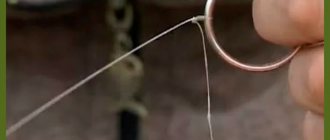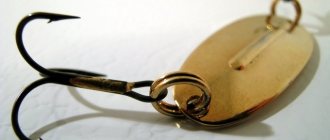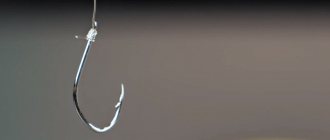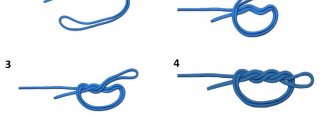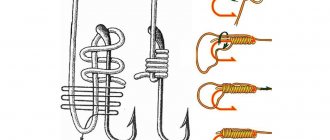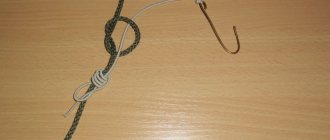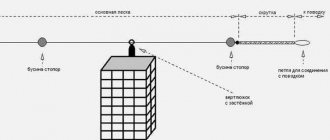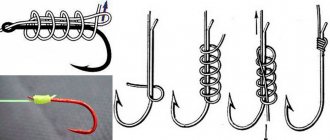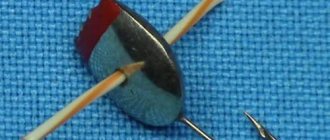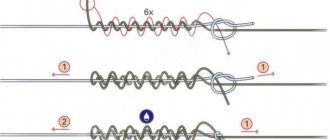Doubles or tees for girders: how to make a choice
As you know, how many people, so many opinions.
This phrase fits perfectly with the topic of this article. Some people prefer to fish with a single hook, others with double hooks, and some exclusively with treble hooks. There is only one thing that opinions agree on - the choice of hook size, most often they use number 10 or 12. It is recommended to choose the type of hook according to the type of bait and the method of baiting. In this article we will look at the features of fishing with doubles and trebles and tell you about the best leashes for pike rigs.
How to tie a hook correctly - your phone will help
While sitting on a lake or river, you can learn the technique of attaching a hook on your tablet or phone if you download the free Fishing Knots app. The program has a clear three-dimensional tying diagram for each type of fastening.
After a dozen trials, you can learn to tie the right knot even by touch. Choose the mount that suits you best.
This article describes the strongest fishing knots for hooks and leashes
, which can be applied in various situations. In your comments, you can leave reviews regarding certain knots, as well as leave your recommendations on the technique of knitting various fishing lines.
Doubles or tees
Doubles
These hooks are used for long-term fishing. The shank of the hook is passed through the gills of the baitfish, and the stings protrude from its mouth. You can use crucian carp or perch as live bait. Depending on which fish predominates in the pike’s habitat. The positive effect of this method of baiting is excellent camouflage. When swallowing live bait, the predator does not feel the hook, so the chance of an unsuccessful bite or the bait breaking tends to zero.
Another advantage is that this method does not injure live bait and allows you to carefully remove the hook and reuse it on your next fishing trip.
The disadvantage of doubles will be the long wait for a bite ; if the hooking is done ahead of time, most likely the predator will break and you will have to start all over again. Such fishing will definitely not fill you with vivid emotions, but for those who like a quiet, relaxing atmosphere, this will be an excellent choice.
Tees
When fishing with a tee, fishing will be more dynamic. Pike react faster if perch is used as bait. The advantage is that the predator does not react to injections. However, it is important to choose small hooks with a short shank .
The best leashes for a female dog
The strongest leashes are made of metal material, but they have a significant drawback: it is very noticeable to the fish. But in winter fishing, when catching pike, this is critical, so strength cannot compensate for it in any way.
Braided steel leashes are also widely used; they are woven from several threads. They are relatively soft and widely available in fishing stores. The disadvantages will also be high visibility for fish, so this is also not the best option. Let's try to figure out which leash for the harness will be better.
A good option would be a tungsten alloy cord; they are quite invisible and can withstand a good load. The disadvantages include the high cost and tendency to deform; after the first bite, the leash will take the shape of a spiral and become more noticeable to the fish.
Fluorocarbon leaders have a number of advantages, which makes them one of the best for pike fishing. Let's take a closer look:
- They do not deform like metal ones, and especially tungsten ones.
- Excellent invisibility for fish, due to the close refractive index of light to water.
- Good abrasion resistance, or rather a low probability that a predator will simply bite it.
- Lightness and elasticity. But despite this, fluorocarbon sinks well.
- High resistance to external factors (ultraviolet, temperature fluctuations, etc.)
The best brands would be:
- Kureha Chemical Industries Co. Ltd;
- Sunline;
- Scientific Anglers.
If financial resources are limited, you can use regular fishing line . You just need to pay special attention to such parameters as:
- Overall strength (biting, tearing, impact);
- Elasticity;
- Abrasion resistance;
- Invisibility for fish.
Important! You can compensate for the insufficient strength of the fishing line by using larger cords from which the braided leash is woven, but this is not a 100% panacea for breaking.
Even with a high breaking load, a predator can bite through it, chewing the fibers one by one. For this reason, the braid must be at least 0.35 mm . In winter, this line can absorb water and freeze to the ice.
The big advantage of monofilament lines is their low cost and low visibility in the water. Also, using such a fishing line, live bait is quite mobile. One of the disadvantages is that it is easy to bite; it is recommended to choose a line thickness of 0.4 mm.
- Fireline from Berkley;
- Power pro manufacturer Shimano;
- Herculine is produced by Sufix.
Note! Information on how to properly tie the leash to the harness is indicated on the box.
Method one without disturbing the equipment
Here we use the well-known Palomar knot. The beauty is that you can install an additional hook right while fishing, in just a few seconds.
Fold the main line in half and thread it through the ring of the hook:
We take double fishing line on both sides of the hook and make a regular knot without tightening:
Place the loop on the hook from the tip side:
Now you can tighten the knot and enjoy your creation:
This method is suitable for use in any fishing method, be it a feeder, spinning rod, or a regular float. It should also be noted that the advantages of this method are simply incredible:
- Possibility to choose the exact location of the hook on the finished equipment.
- This knot is suitable for both braid and monofilament.
- The knitting speed of this knot is simply lightning fast.
The only disadvantage we can note is that it is not always easy to insert the folded fishing line into the ring of the hook, and then you have to resort to other solutions.
How to tie a hook correctly - Palomar knot
The Palomar is a strong, flexible knot that is used in most situations for catching all types of fish. Its disadvantage is considered to be the difficulty of passing the fishing line through the eye. The knot also cannot be used for braids. Palomar is by far the strongest attachment available because the line's strength doubles as it passes through the eye of the hook.
- First, bend the thread to create about a 15cm double line, then thread it through the hole of the hook.
- Tie a simple knot “on top” of the hook.
- Place the loop on the forend.
- Tighten the knot and trim the free end.
- Make sure the two rings of thread are parallel.
Second high-speed method
This version of the knot involves cutting the required length of the leash, attaching hooks, and then installing the leash on the tackle.
Take the first hook and thread the fishing line into it:
We press the threaded end of the fishing line to the forend, and make 6-7 turns around the fishing line and forend with the remaining ones:
We pass the long end of the fishing line into the ring of the hook from below and tighten the knot by pulling the hook and the long piece of fishing line:
We put the second hook on a piece of fishing line, select the desired distance, and repeat the above operations:
In the end, all that remains is to install the leash on the fishing line and start fishing. The speed of tying a hook this way is simply amazing. Even if you are not going to use it, I recommend trying to tie this knot, you will be amazed at its convenience.
Among the advantages are the speed of knitting, as well as the ability to install an unlimited number of hooks. This knitting option is suitable for making a winter “garland”, as well as when fishing with live bait.
The third standard fishing method
I think this method of tying a second hook has occurred to any angler. Here we knit an additional hook in our favorite way, only leaving the short end of the fishing line longer than usual, and then tie the main hook.
In my case, and I knit hooks with a gripping knot, it turns out as follows:
We thread the fishing line into the ring of the hook, and wrap it around the main fishing line 5-7 times:
Now we thread the fishing line into the loop formed near the hook loop:
The next step is to tighten the knot but not completely:
After this, we take the hook in one hand, and the main fishing line in the other, and finally tighten it, after which we will have a fairly strong connection.
Now we can attach the main hook and start fishing. As a result, the equipment will look like this:
This option for installing an additional hook creates a kind of outlet that prevents the main hook from getting caught in the fishing line. This allows you to make long casts, as well as fish from the hole in winter.
How to increase your fish catch?
Over 7 years of active fishing, I have found dozens of ways to improve the bite. Here are the most effective ones:
- Bite activator . This pheromone additive attracts fish most strongly in cold and warm water. Discussion of the bite activator “Hungry Fish”.
- Increased gear sensitivity. Read the appropriate manuals for your specific type of gear.
- Pheromone -based lures .
How to tie a figure eight knot
- Make the first loop, then the second;
- We make a revolution of the first loop, which we pass into the second and as a result we get a “figure eight”;
- Wet the knot;
- Adjust the size of the loop;
- Tighten the knot.
Figure Eight Knot
How to attach a leash to a fishing rod
The leash is usually attached to the main line of the float rod using the “loop-to-loop” method or using a swivel.
The first option does not require the use of additional devices, but sometimes the leashes can get twisted and therefore swivels are used.
Swivels for float tackle should be very small, since such tackle is very sensitive and fractions of grams of the weight of the swivel affect the load of the float.
Tying a leash (video)
Method four: install a hook with a spatula
Yes, hooks with a spatula are quite versatile, and when you think: “Why are they needed,” they come in handy. This type of hook can be tied without breaking the rig, which gives another reason to carry them with you. Unfortunately, I don’t have such a huge hook with a spatula, but I think everything will be clear with a regular hook.
Fold the fishing line in half and apply it to the shank of the hook:
At the end of the fishing line, where the main hook is, we make 6-7 turns around the fishing line and fore-end:
We thread the main hook into the resulting loop:
All that remains is to tighten the knot and start fishing:
This knot can also be used to tie a hook with a ring, but the hook must be of fairly high quality so that the hook ring does not cut the fishing line. There are several other spatula hook knots that can be successfully used to install a second hook.
For braided cords
Braided fishing lines are distinguished by their selectivity of knots, so in order to securely attach the hook, you need to choose special knots. Usually a knot is the weak point of the braid, and it is at this point that it breaks. There is such an indicator - tensile strength, according to which the method of tying is chosen, taking into account the configuration of the braid itself, how round it is.
Palomar Knot (Palomar) - Californian knot, recommended for many braids. Although it is not difficult to tie, it is at the same time reliable and recommended by many companies for tying hooks, for example, the American Berkley. But it is not suitable for thick fishing lines, since the fishing line used is folded in half, the eye must be large. It is not suitable for hooks with a spatula.
Knot "Palomar"
Snell Knot – used for eye hooks. For models with a spatula, it is less suitable, because in this case you will have to make more turns, which makes knitting more difficult. In this type of knitting, 7-8 turns are made around the fore-end. The connection of the hook to the fishing line should be even, without overlaps.
Uni Knot (Uni) - also called Duncan, in honor of the creator, and also universal - is used for tying a hook with an eye to braid, monofilament, fluorocarbon.
In this video you can see how Uni Knot is knitted:
Rapala is a well-known knot among fishermen and is often used.
Rapala
Method five: using leashes
Another option is to use a leash. Although this is a little off topic, this method deserves publicity, since sometimes the bite is even better than with two blind hooks.
We knit a loop on the main fishing line; to do this, fold the fishing line in half and tie a regular knot:
We tighten the knot on the loop, and thread a pre-prepared leash with the same loop at the end into the loop:
All that remains is to thread the hook into the loop of the leash and tighten:
The result is something like this:
Select the length of the leash individually, depending on the fishing conditions. There are also many more ways to install leashes, which you can read about HERE. One of the advantages of this method is the ability to adjust the position of the bait.
This is achieved by replacing the leash with a longer or shorter one. The downside is that the leashes often overlap, especially when fishing at a distance.
Let's finish here, all methods are quite effective in certain fishing conditions. Personally, I use the first and third methods. If you have any questions or suggestions, write in the comments.
How to increase your fish catch?
Over 7 years of active fishing, I have found dozens of ways to improve the bite. Here are the most effective ones:
- Bite activator . This pheromone additive attracts fish most strongly in cold and warm water. Discussion of the bite activator “Hungry Fish”.
- Increased gear sensitivity. Read the appropriate manuals for your specific type of gear.
- Pheromone -based lures .
As you know, in water the strength of fishing lines decreases by about 20-30%, which, of course, must be remembered and taken into account when installing gear.
If the knots are chosen incorrectly, and even tied poorly, the strength of the fishing line is reduced by more than half. It is the knots that largely determine whether your favorite bait, along with the potential catch, will remain in the reservoir forever.
In this article we will look at various fishing knots applicable to both monofilament and braided fishing line. Methods of tying leashes to the main line and methods of tying hooks to leashes will be discussed.
How to knit leashes for fishing
If you are interested in the topic of coil repair and maintenance, we recommend the article - disassembling and lubricating coils
Methods for attaching leashes:
- fisherman's knot
- loop to loop
- retractable leash via swivel
- snake knot
- running node
- surgical knot
- Palomar
Fisherman's knot
A well-known knot that is knitted quite quickly and without any complicated tricks, and therefore is suitable for beginners without experience. A fisherman's knot can be easily tied while fishing.
How to tie a leash to the main line so that it does not hang
Many fishermen in summer, and especially winter fishing, use a so-called additional side leash in their equipment. This leash is usually made from a fishing line of the same diameter as the main one, and is attached at various distances from the lower jig or devil.
In the lower part, the closure of the tackle can also be a sinker. How to properly tie a leash so that it does not get tangled with the main fishing line, read this article.
How to tie a hook correctly - the knotless method
This knot is especially popular among carp anglers. Various attachments (bubbles) can be attached to the loop itself.
- Tie a loop at the end of the thread to hold the bait. Thread the other end through the eye of the lure and adjust the loop to the desired position.
- Carefully make 5 to 8 turns around the shank of the hook.
- After the last turn, pass the free end along the hook.
- While holding the end of the loop in position, pull the loose end through the eyelet.
How to tie a leash to the main line so that it does not hang down parallel to the main line
An additional side leash is used to attach an additional hook or an additional jig to the main fishing line.
This article discusses the question of how to tie a leash (retractable) to the main fishing line so that it does not hang, but has a certain elasticity and an additional hook with an attachment or an additional jig, it can be either reelless or not, do not hang parallel and too close to the main line and thus do not get confused with it when fishing and fishing.
For clarity, we will consider the knot for tying this leash using the example of ropes of two colors. Green color is the main line. Red – additional leash.
On the main line we make one turn of the loop.
We insert the end of the leash into the loop, which we will tie to the main fishing line.
Next, with this end we form a half-loop parallel to the main fishing line. The most important thing is that the half-loop should be at the bottom of the rig, that is, facing the lower jig or sinker.
Next, with the free end we make several turns around the half-loop and the main line. The number of turns that need to be made depends on the diameter of the fishing line used. Usually my ratio is this: line diameter 0.08 mm - 8 turns, 0.1 mm - 7 turns, 0.12 - 6 turns, then when the diameter increases less than 5 turns, I don’t do it.
Next, pass the free end into the half-loop.
As you can see, in the knot the line to which the hook or jig will be attached comes out of the knot almost parallel to the main one and is directed almost upward to the fishing rod.
This position of the fishing line in the knot gives the tied leash additional elasticity and, depending on the diameter of the fishing line, with diameters from 0.12-0.14 mm, the leash with the hook is located almost perpendicular to the main one.
Of course, we are talking here about reasonable lengths. And long leashes will only worsen the performance of the tackle and will get tangled, since the weight of the nozzle or bait can be added to the weight of the hook or jig.
All that remains is to tie a hook of the size you need or a jig to the end of the leash. True, I always do the opposite, first I prepare several leashes with attached hooks or jigs, and then weave them into the main fishing line. This makes it easier to control the length of the resulting leash.
How to tie two hooks
Often you have to tie several hooks on a fishing line, for example, two that are attached to leashes. In this case, you need to tie leashes, the number of which is not limited, but from experience you should not put more than three. You need to tie it so that your leash does not slip. We knit the first one that will be below, then the second and, if necessary, the third.
The easiest and fastest way to attach leashes with hooks is to use swivels and fasteners; this method of attachment will allow you to quickly change the leash while fishing. To prevent the leashes from twisting between themselves and the main fishing line, cambrics are used, which are put on the fishing line and installed at the attachment point. Leashes are made in different sizes to prevent them from getting tangled. Although the strongest fastening is a knotless fastening, in this case the fastening holds the load, but the fishing line may break in another place.
If this method using swivels is unacceptable, then you can tie the leash to the main fishing line using the loop-to-loop method.
A tee or double is tied both on the main line and on the leash. Use NoKnot fastening.
In the video, watch how hooks are tied to a fishing line for live bait fishing without using a leash, NoKnot:
Of course, this article does not list all the ways to tie hooks to fishing line; in fact, there are many more of them. But I tried to tell you about the most popular and effective ones.
Popular legend: The largest fish bites on a loosely tied hook.
Photo with additional hooks on the side leashes.
The minimum size used here is a fishing line of 0.08 mm and a hook number 16. As you can see, the leash with the hook is almost perpendicular to the main fishing line. When attaching bait (raspberry or mormysh), its downward bend will be insignificant, and the hook with bait will not come into contact or get tangled with the main fishing line, and if all the gear is carried in height, the play of the bait will be much more interesting and richer, which will inevitably affect the increase number of bites.
Photo with an additional jig attached.
Here you can see that under the weight of the jig the line of the leash has sagged, but still neither the jig nor the leash touches it. This is also very useful if you equip your winter fishing rods with additional leaders and jigs.
At the end of the article I will share equipment for catching winter bream. And in the summer, from a boat, large bream (from 3 kg and above) confidently take such equipment, and I often use it.
Photo of equipment for catching bream using a tied leash on the main line
It is based on an additional leash and a simple sinker. The sinker is tied to the end of the main line. At a distance of 3 cm from the sinker, a leash with a hook, also 3 cm long, is tied. Thus, with a bunch of raspberries attached, the sinker and hook form, figuratively speaking, an isosceles triangle.
Fishing is carried out from a boat with a winter fishing rod. The nod is used for fishing with the devil. The wiring is carried out in a variety of ways, almost like a devil, but mainly with maximum amplitude. Bream bites are also common when the tackle is slowly lowered.
My equipment parameters for catching bream in the summer from a boat are for a depth of 8-10 m: line - 0.12, hook No. 14, weight - 1.25 g. In winter, I use more delicate tackle: for bream - line 0.1 mm , hook No. 14.16 for roach - it also does not pass by this equipment, fishing line 0.08 mm, hook No. 16.18.
Author: Alexey Brevnov.
How fishermen of the Far North salt fish
The northern regions are a traditional fishing region. Northern peoples know how to cook fish dishes superbly. They know thousands of recipes and hundreds of nuances.
Fish dishes prepared by northern fishermen are always incredibly tasty, moderately salted and with a well-chosen set of seasonings and spices.
A Yakut fisherman shared a recipe for salting fish, which I would like to talk about in this publication.
Northern fish is incredibly tasty. Grayling
After the recipe was tested by one of our authors, we decided to publish it on the resource pages.
Let's say right away that the fish turned out very tasty. And the recipe itself is simple to the point of banality.
